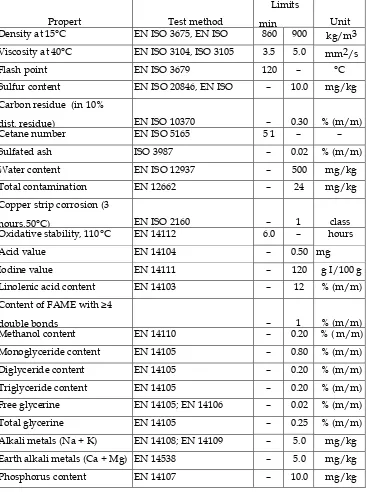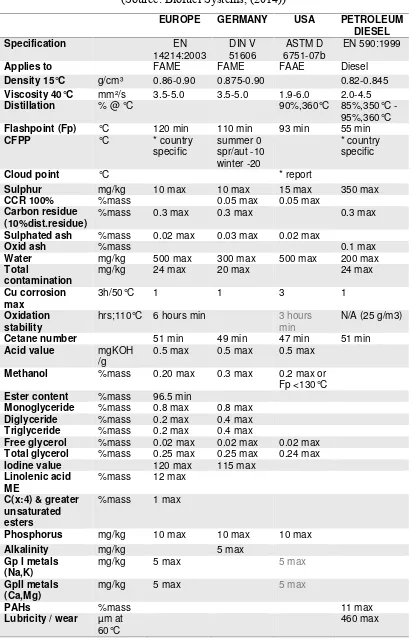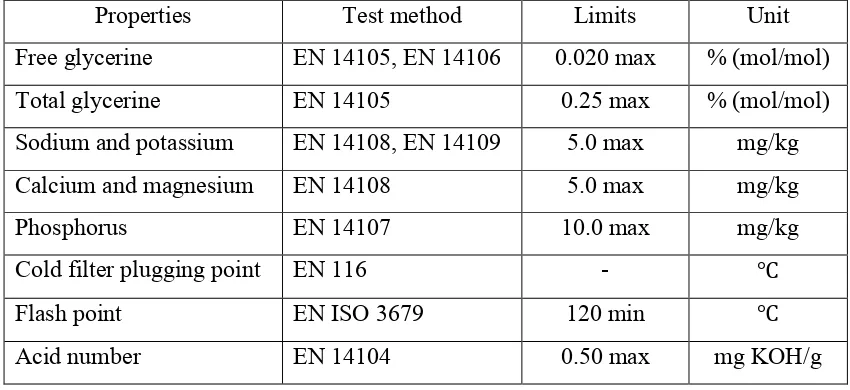SUPERVISOR DECLARATION
“I hereby declare that I have read this thesis and in my opinion this thesis is sufficient in terms of scope and quality for the award of the degree of
Bachelor of Mechanical Engineering (Automotive)”
Signature: ………. Supervisor: MOHD TAUFIK BIN TAIB
PARAMETRIC STUDY OF BIODIESEL PROPERTIES TO THE STORAGE CONDITION
FARIS BIN AZMAN
This report is submitted in partial fulfillment of the requirements for the award Bachelor of Mechanical Engineering (Automotive)
Faculty of Mechanical Engineering Universiti Teknikal Malaysia Melaka
ii
DECLARATION
“I hereby declare that the work in this thesis is my own except for summaries and quotations which have been duly acknowledged.”
Signature: ………. Author: FARIS BIN AZMAN
iii
To my
iv
ACKNOWLEDGEMENT
v
ABSTRACT
vi
ABSTRAK
vii
TABLE OF CONTENTS
CHAPTER TOPIC PAGE
DECLARATION ii
DEDICATION iii
ACKNOWLEDGEMENT iv
ABSTRACT v
ABSTRAK vi
TABLE OF CONTENTS vii
LIST OF TABLES x
LIST OF FIGURES xii
LIST OF SYMBOLS xiii
LIST OF ABBREVIATION xiv
1 INTRODUCTION 1
1.1 Background of Study 1
1.2 Objective 8
1.3 Problem Statement 8
1.4 Scope 8
2 LITERATURE REVIEW 9
2.1 Introduction 9
2.2 Free Glycerine 10
2.2.1 Gas chromatography 10
viii
CHAPTER TOPIC PAGE
2.4 Sodium And Potassium 13
2.4.1 Atomic Absorption Spectrometry 14 2.4.2 Inductively Coupled Plasma And
Subsequent Optical Emission Spectroscopy
15
2.5 Calcium And Magnesium 16
2.6 Phosphorus 16
2.7 Cold Filter Plugging Point 17
2.7.1 Automated CFPP Tester 17
2.8 Flash Point 18
2.8.1 Setaflash Series 3 Plus Closed Cup Tester 19
2.9 Acid Number 19
2.9.1 Volumetric Titration Method 20
2.10 Ester 21
2.10.1 Fourier Transform Infrared Spectoscopy 21
2.11 Equipment Available 22
3 METHODOLOGY 23
3.1 Introduction 23
3.2 Flow Chart 24
3.3 Project Preparation 25
3.4 Setaflash Series 3 Plus Closed Cup Tester 27
3.4.1 Before Experiment 27
3.4.2 During Experiment 27
3.4.3 After Experiment 28
3.5 Volumetric Titration Method 28
3.5.1 Before Experiment 28
3.5.2 During Experiment 29
ix
CHAPTER TOPIC PAGE
3.6 Fourier Transform Infrared Spectroscopy 32
3.6.1 Before Experiment 32
3.6.2 During Experiment 32
3.6.3 After Experiment 32
4 RESULTS AND ANALYSIS 33
4.1 Introduction 33
4.2 Flash Point 33
4.3 Acid Number 35
4.4 Ester 36
5 DISCUSSION 40
5.1 Introduction 40
5.2 Flash Point 40
5.3 Acid Number 43
5.4 Ester 45
6 CONCLUSION AND RECOMMENDATION 47
6.1 Conclusion 47
6.2 Recommendation 48
REFERENCES 49
x
LIST OF TABLES
NO TOPIC PAGE
1.1 European Standard for Biodiesel (EN 14214)
(Source: Barabas and Todorut, 2011) 5
1.2 ASTM Standard for Bioidesel (ASTM 6751)
(Source: Alternative Fuels Data Center, 2014) 6 1.3 Comparison Between European, Germany, American and
Petroleum Diesel for Biodiesel
(Source: Biofuel Systems, 2014) 7
2.1 European Biodiesel Standards EN 14214 9
3.1 Flash Point of B100 Samples 28
3.2 Flash Point of Standard Diesel Samples 28
3.3 Acid Number of B100 Samples 30
3.4 Acid Number of Standard Diesel Samples 31
4.1 Flash Point of B100 33
4.2 Flash Point of Standard Diesel 34
4.3 Acid Number of B100 35
4.4 Acid Number of Standard Diesel 36
xi
LIST OF FIGURES
NO TOPIC PAGE
1.1 Chemical Reaction in Producing Biodiesel
(Source: Gog et al., 2014) 3
2.1 Gas Chromatography Schematic Diagram
(Source: Sheffield Hallam University, 2014) 10 2.2 Split/Splitless Injection
(Source: Sheffield Hallam University, 2014) 11 2.3 Fused Silica Open Tubular (FSOT)
(Source: Thet and Woo, 2014) 12
2.4 AAS Equipment
(Source: Wikipedia, 2014) 14
2.5 ICP-OES Equipment
(Source: Wikipedia, 2014) 15
2.6 Tanaka AFP-102 CFPP Tester
(Source: Tanaka, 2014) 17
2.7 Neslab RTE-7 D1 Refrigerated Bath
(Source: Artisan, 2014) 18
2.8 Setaflash Series 3 Plus Closed Cup Tester
(Source: Stanhope-Seta, 2015) 19
2.9 Volumetric Titration Method
(Source: Doc Brown’s, 2015) 20
2.10 Esterification Process
(Source: TutorVista, 2015) 21
xii
NO TOPIC PAGE
3.1 PSM Flow Chart 24
3.2 Samples Preparation 25
3.3 Hot Temperature Storage Condition 26
3.4 Cold Temperature Storage Condition 26
3.5 Ambient Temperature Storage Condition 26
4.1 Sample Results in Week 0 37
4.2 Sample Results in Week 1 37
4.3 Sample Results in Week 2 38
4.4 Sample Results in Week 3 38
4.5 Sample Results in Week 4 39
5.1 Flash Point of B100 in Storage Conditions 41
5.2 Flash Point of B100 and Standard Diesel 42
5.3 Acid Number of B100 in Storage Conditions 43
5.4 Acid Number of B100 and Standard Diesel 44
5.5 Ester of B100 and Standard Diesel 45
xiii
LIST OF SYMBOLS
-OCH3 = Methoxide ion
Na = Sodium
K = Potassium
Ca = Calcium
Mg = Magnesium
P = Phosphorus
NaOH = Sodium Hydroxide
KOH = Potassium Hydroxide
xiv
LIST OF ABBREVIATION
PSM - Projek Sarjana Muda
UTeM - Universiti Teknikal Malaysia Melaka FKM - Faculty of Mechanical Engineering
BMCA - Bachelor in Mechanical Engineering Automotive CFPP - Cold Filter Plugging Point
FAME - Fatty acid methyl ester
B5 - 5% biodiesel and 95% petroleum diesel B100 - 100% biodiesel
EN - European Norm
ASTM - 2. American Society for Testing and Materials DIN - Deutsches Institut für Normung
GC - Gas chromatography
WCOT - Wall-coated open tubular SCOT - Support-coated open tubular FSOT - Fused silica open tubular
ICP-OES - Inductively coupled plasma and subsequent optical emission spectroscopy
AAS - Atomic absorption spectrometry PMT - Photomultiplier tube
ICP - Inductively coupled plasma FTIR - Fourier Transform Infrared
FKP - Faculty of Manufacturing Engineering UTHM - Universiti Tun Hussein Onn Malaysia PPE - Personal Protective Equipment
1
CHAPTER 1
INTRODUCTION
1.1 BACKGROUND OF STUDY
Biodiesel is defined as the mixture of monoalkyl esters of fatty acid methyl ester (FAME) such as vegetable oils, animal fats, cooking oil or algae oil which are parts of the renewable biological sources (Gog et al., 2014). Sharma et al. (2008) states that renewable fuel such as biodiesel with less exhaust emissions better than petroleum diesel which is a non-renewable fuel that emit many form of pollutants and last for limited period of time. Nowadays, petroleum prices keep rising as the result of its amount continue to decrease and higher demand in industry and high usage in daily life of people around the world. Therefore, the research and development of biodiesel is being focused on the optimization of process to meet the specification and standards required for the renewable energy source or fuel to be used commercially and worldwide without decreasing or reducing the durability and efficiency of engine parts. Biodiesel is now becoming one of the alternatives to partially fulfill expected future energy demands especially in transport sector.
2
Basically, there are three basics paths for the biodiesel production from oils and fats which are base catalysed transesterification of the oil, direct acid catalysed transesterification of the oil and lastly, enzymatic catalysed transesterification of the oil. Base catalysts are highly sensitive to moisture and free fatty acid contents which causes a partial reaction of saponification causing the consumption of the catalyst and reduction in catalytic efficiency. Acid catalysts are used when the acid value of the feedstock is higher than the performance range of the base catalysts. Both type of catalysts have disadvantages like being energy-intensive, difficult to recover glycerol, difficulty in removal of the excess catalyst from product, treatment of alkaline waste water and interference of free fatty acids and water in the reaction (Yan et al., 2014). Enzymatic transesterification on the other hand is better because of lower energy consumption, biodiesel easily separated from the reaction mixture and biodiesel purification is easier. However, in industry, base catalysts are most preferred because of the higher speed reaction, lower reaction temperature and higher conversion efficiency.
3
Figure 1.1: Chemical Reaction in Producing Biodiesel (Source: Gog et al., (2014))
A successful transesterification reaction is determined by the separation of the biodiesel and glycerine layers after the reaction time. The glycerine produced is useful in other industry such as food industry and pharmaceutical but the contaminants need to be removed to obtain the pure glycerine and attain commercial value. In addition, automation industry especially for the diesel engine industry, the engine combustion also benefits from the good and completed process of the transesterification of the oil.
The completed biodiesel must be analysed using appropriate and suitable equipment in order to ensure that it meets the specific requirements needed. The most important aspects of biodiesel production to ensure smooth and good operation in diesel engine are:
1. Complete reaction 2. Removal of glycerine 3. Removal of catalyst 4. Removal of alcohol
5. Absence of free fatty acids
4
The storage condition of the biodiesel is also important. One of the aspects that are hard to control in storage condition is temperature. Whether its the heat during day or cold during night, the change in temperature may affect the biodiesel inside the storage that possibly contribute to the degradation of biodiesel.
Biodiesel has a number of standards for its quality. Most commonly standards seen are B5, B20 and B100. The “B” alphabet of the acronyms shows the percentage of biodiesel blend like B5 shows the diesel oil is 5% biodiesel and 95% petroleum diesel. Each of the standards has its own usage especially B5 which is now widely use in vehicle that use diesel engine.
5
Table 1.1: European Standard for Biodiesel (EN 14214) (Source: Barabas and Todorut, (2011))
Propert y Test method Limits min max Unit
Density at 15°C EN ISO 3675, EN ISO
12185
860 900 kg/m3
Viscosity at 40°C EN ISO 3104, ISO 3105 3.5 5.0 mm2/s
Flash point EN ISO 3679 120 – °C
Sulfur content EN ISO 20846, EN ISO
20884
– 10.0 mg/kg
Carbon residue (in 10%
dist. residue) EN ISO 10370 – 0.30 % (m/m)
Cetane number EN ISO 5165 5 1 – –
Sulfated ash ISO 3987 – 0.02 % (m/m)
Water content EN ISO 12937 – 500 mg/kg
Total contamination EN 12662 – 24 mg/kg
Copper strip corrosion (3
hours,50°C) EN ISO 2160 – 1 class
Oxidative stability, 110°C EN 14112 6.0 – hours
Acid value EN 14104 – 0.50 mg
KOH/g
Iodine value EN 14111 – 120 g I/100 g
Linolenic acid content EN 14103 – 12 % (m/m)
Content of FAME with ≥4
double bonds – 1 % (m/m)
Methanol content EN 14110 – 0.20 % ( m/m)
Monoglyceride content EN 14105 – 0.80 % (m/m)
Diglyceride content EN 14105 – 0.20 % (m/m)
Triglyceride content EN 14105 – 0.20 % (m/m)
Free glycerine EN 14105; EN 14106 – 0.02 % (m/m)
Total glycerine EN 14105 – 0.25 % (m/m)
Alkali metals (Na + K) EN 14108; EN 14109 – 5.0 mg/kg
Earth alkali metals (Ca + Mg) EN 14538 – 5.0 mg/kg
6
7
Table 1.3: Comparison Between European, Germany, American and Petroleum Diesel for Biodiesel
(Source: Biofuel Systems, (2014))
Biodiesel Standards EUROPE GERMANY USA PETROLEUM
DIESEL
Specification EN
14214:2003 DIN V 51606 ASTM D 6751-07b EN 590:1999
Applies to FAME FAME FAAE Diesel
Density 15°C g/cm³ 0.86-0.90 0.875-0.90 0.82-0.845
Viscosity 40°C mm²/s 3.5-5.0 3.5-5.0 1.9-6.0 2.0-4.5
Distillation % @ °C 90%,360°C 85%,350°C -
95%,360°C
Flashpoint (Fp) °C 120 min 110 min 93 min 55 min
CFPP °C * country specific summer 0 spr/aut -10 winter -20 * country specific
Cloud point °C * report
Sulphur mg/kg 10 max 10 max 15 max 350 max
CCR 100% %mass 0.05 max 0.05 max
Carbon residue (10%dist.residue)
%mass 0.3 max 0.3 max 0.3 max
Sulphated ash %mass 0.02 max 0.03 max 0.02 max
Oxid ash %mass 0.1 max
Water mg/kg 500 max 300 max 500 max 200 max
Total
contamination
mg/kg 24 max 20 max 24 max
Cu corrosion max
3h/50°C 1 1 3 1
Oxidation stability
hrs;110°C 6 hours min 3 hours min
N/A (25 g/m3)
Cetane number 51 min 49 min 47 min 51 min
Acid value mgKOH
/g
0.5 max 0.5 max 0.5 max
Methanol %mass 0.20 max 0.3 max 0.2 max or
Fp <130°C
Ester content %mass 96.5 min
Monoglyceride %mass 0.8 max 0.8 max
Diglyceride %mass 0.2 max 0.4 max
Triglyceride %mass 0.2 max 0.4 max
Free glycerol %mass 0.02 max 0.02 max 0.02 max
Total glycerol %mass 0.25 max 0.25 max 0.24 max
Iodine value 120 max 115 max
Linolenic acid ME
%mass 12 max
C(x:4) & greater unsaturated esters
%mass 1 max
Phosphorus mg/kg 10 max 10 max 10 max
Alkalinity mg/kg 5 max
Gp I metals (Na,K)
mg/kg 5 max 5 max
GpII metals (Ca,Mg)
mg/kg 5 max 5 max
PAHs %mass 11 max
Lubricity / wear µm at 60°C
8
1.2 OBJECTIVE
The following are the objectives to be achieved in this project:
1. To understand the test method used to produce biodiesel standards
2. To investigate the selected biodiesel properties by performing experimental work under storage condition
3. To analyse and to compare the results with existing biodiesel standard under storage condition
1.3 PROBLEM STATEMENT
Throughout this project, there are several aspects need to be considered. First of all is to find the simplest method to determine the biodiesel properties. Next, the storages must be correctly set up to maintain the temperature which are hot, ambient and cold storage conditions. Besides that, the biodiesel properties need to be determined under storage condition to know whether there are differences with the properties according to biodiesel standard.
1.4 SCOPE
9
CHAPTER 2
LITERATURE REVIEW
2.1 INTRODUCTION
From the all of the properties listed in the biodiesel standards, the properties that are been investigated to be determined the value or the amount of the contents inside the biodiesel are the first group of alkali metals, sodium and potassium (Na + K), the second group of alkali metals, calcium and magnesium (Ca + Mg), phosphorus (P), free glycerine, total glycerine, cold filter plugging point, acid number, flash point and ester. The following Table 2.1 shows the properties with its test method, limits and units based on European Biodiesel Standards EN14214:
Table 2.1: European Biodiesel Standards EN 14214
Properties Test method Limits Unit
Free glycerine EN 14105, EN 14106 0.020 max % (mol/mol)
Total glycerine EN 14105 0.25 max % (mol/mol)
Sodium and potassium EN 14108, EN 14109 5.0 max mg/kg
Calcium and magnesium EN 14108 5.0 max mg/kg
Phosphorus EN 14107 10.0 max mg/kg
Cold filter plugging point EN 116 - ℃
Flash point EN ISO 3679 120 min ℃



